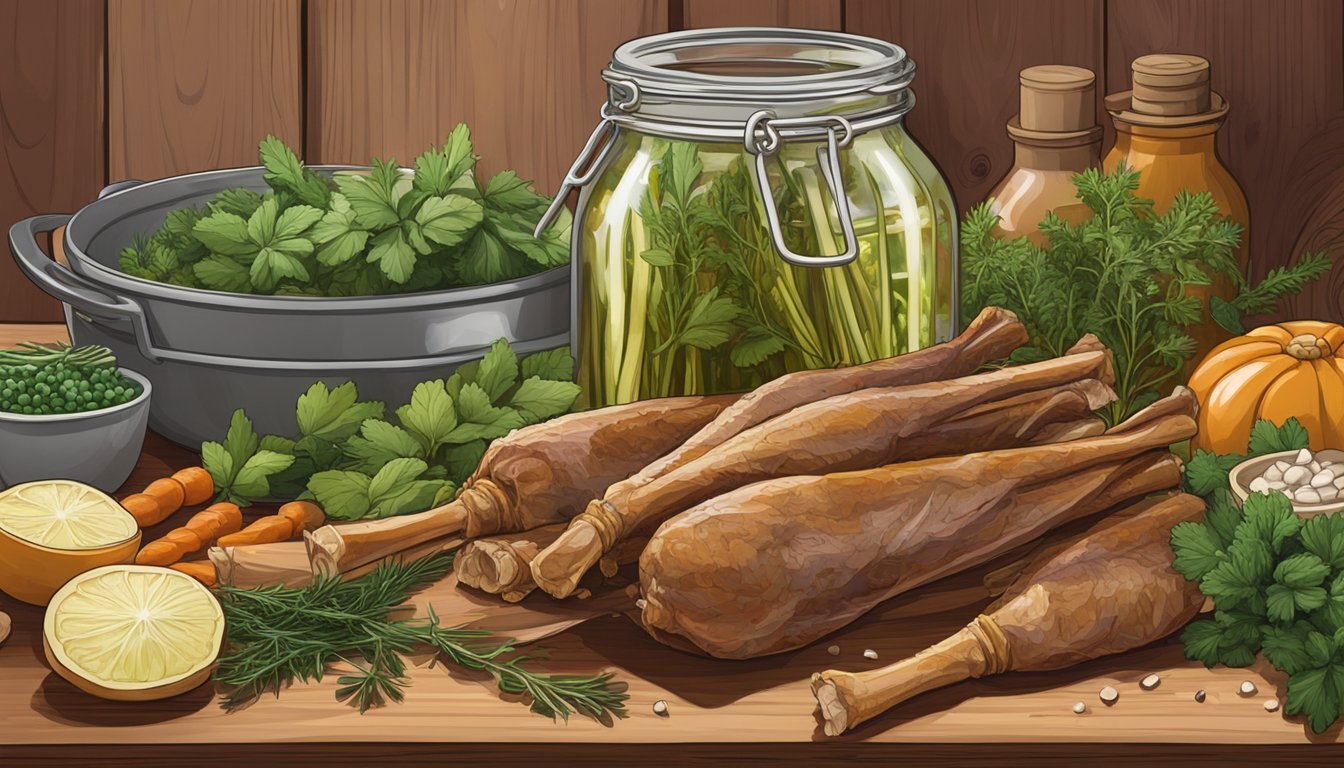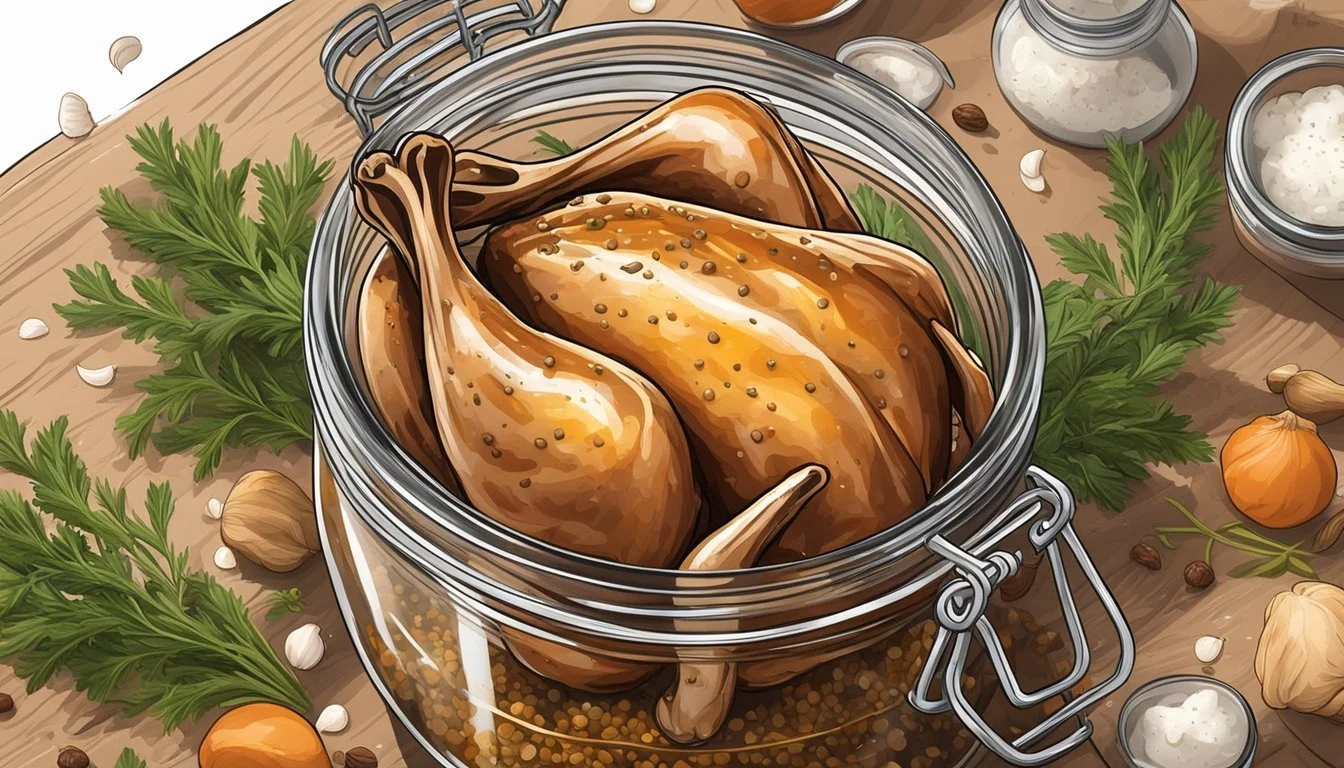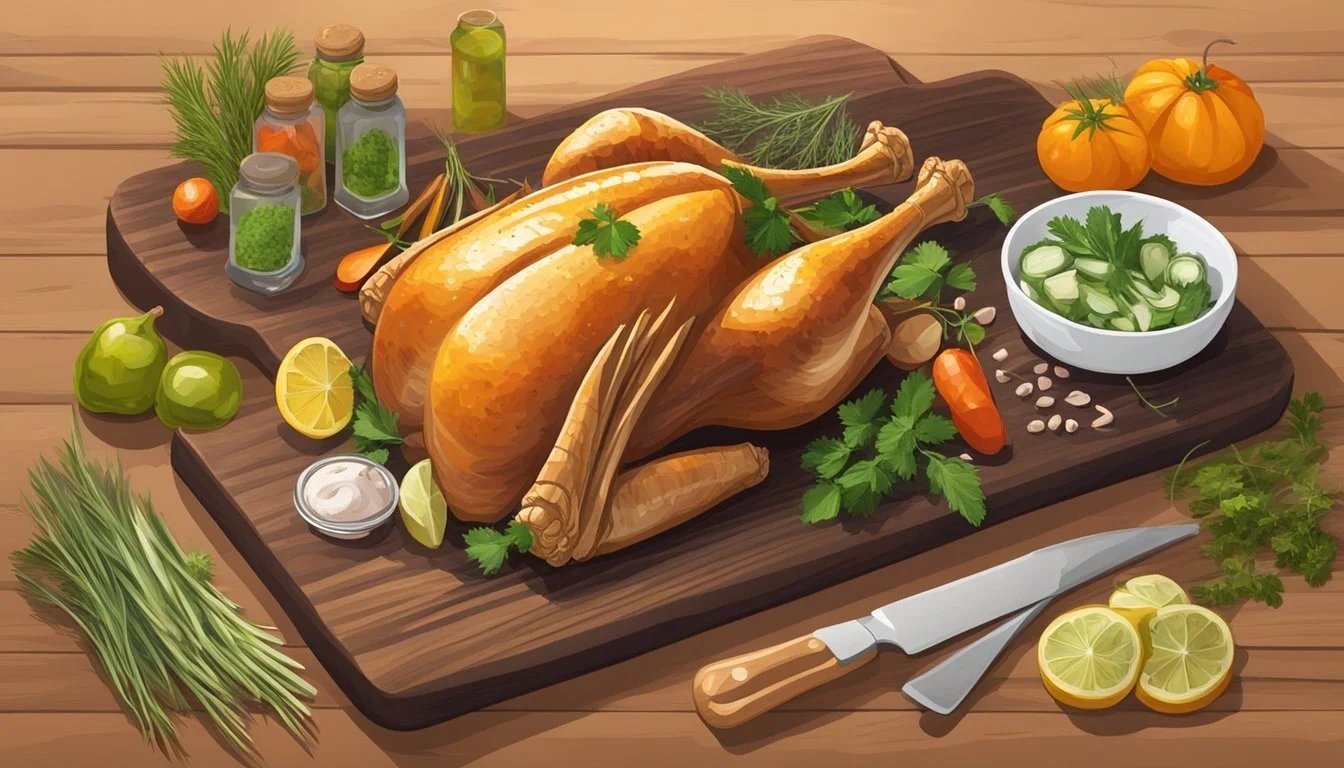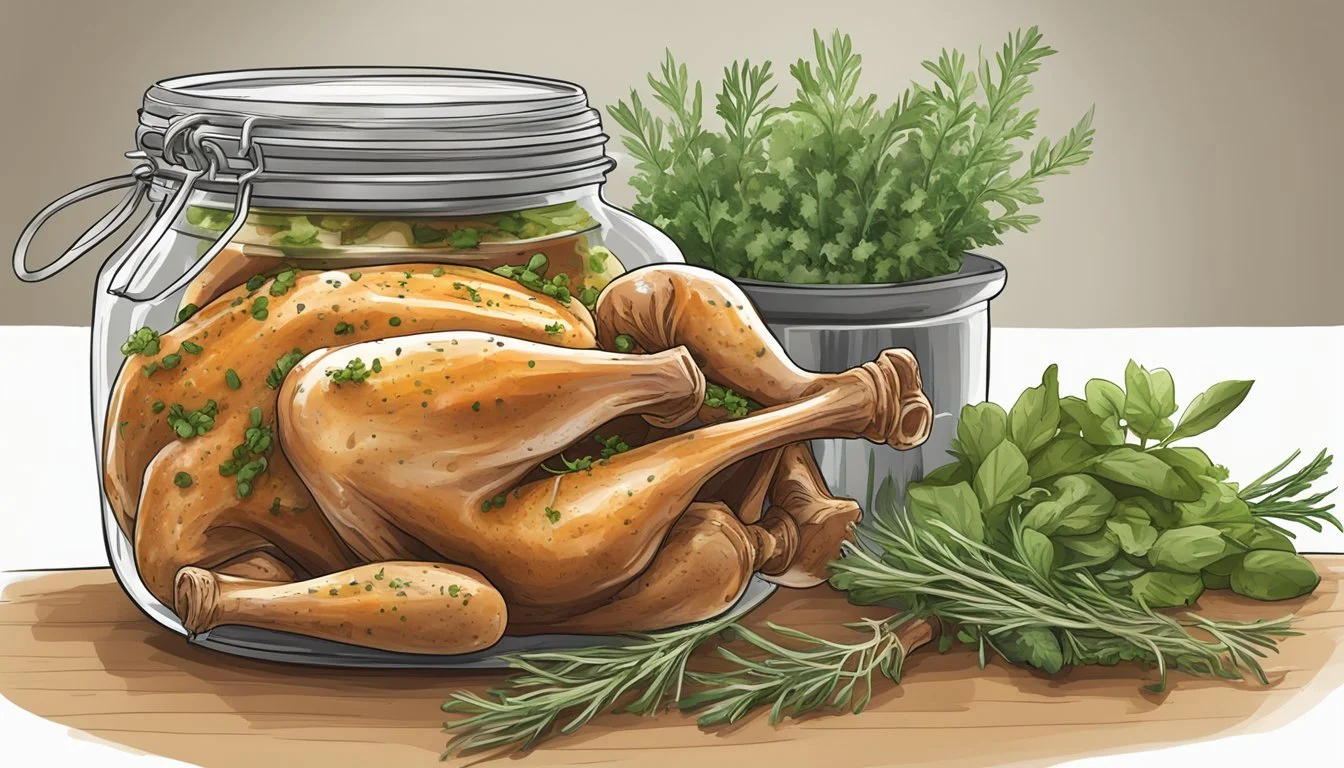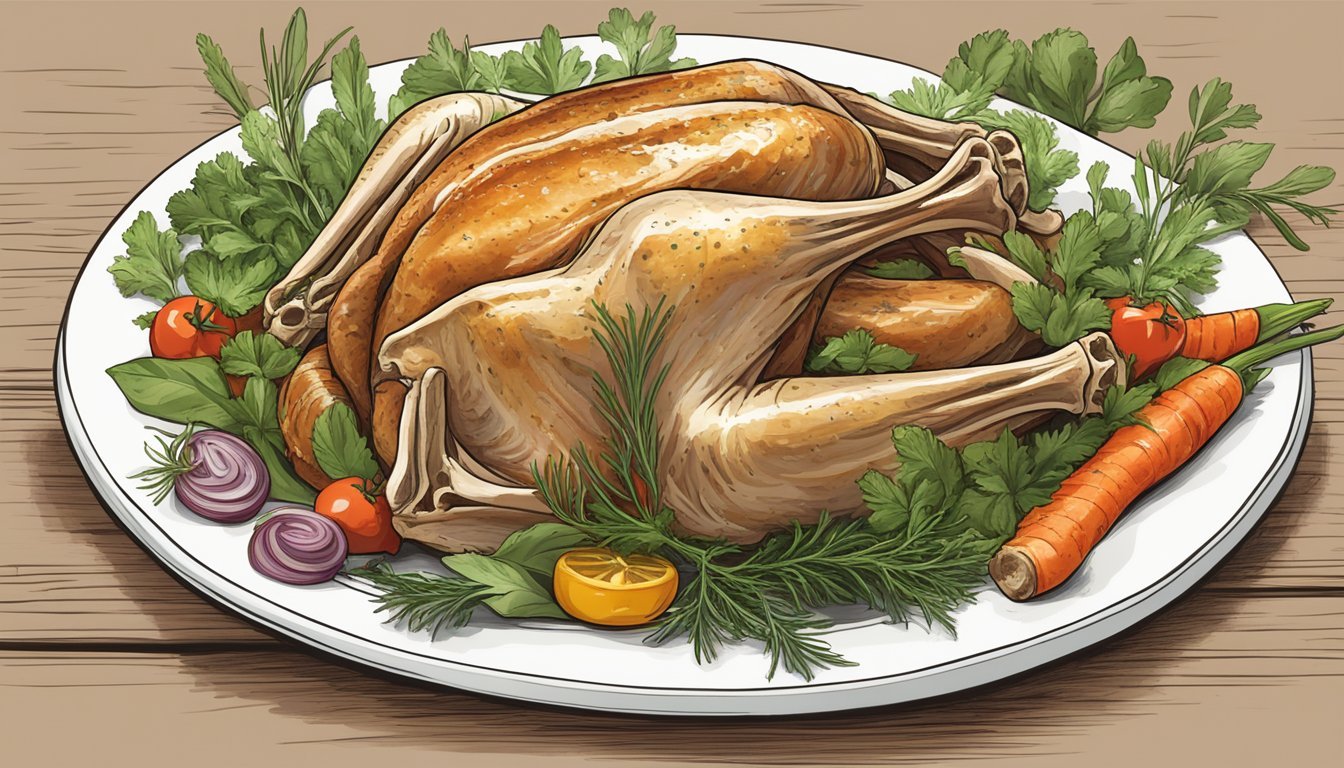Pickled Turkey Legs
Simplified Gourmet Delicacy for Home Deli Enthusiasts
Turkey legs are a robust and flavorful cut of meat that can be enjoyed in various ways, but one unique preparation that stands out is pickling. The process of pickling meats, a method dating back centuries, enhances flavors and preserves the produce. When adapted to turkey legs, it yields a tangy and savory delicacy that is ideal for those looking to broaden their home deli options. The infusion of aromatic pickling spices and the blend of vinegar creates a dish that retains the meat's succulence while introducing an appetizing zing.
For home chefs looking to delve into pickled meats, turkey legs offer an excellent starting point due to their size and texture. The meat, known for its richer taste compared to the more common chicken, pairs exceptionally well with the sharpness of the pickling brine. Crafting this specialty at home allows for customization of seasonings, letting each cook personalize the balance of sweetness, spice, and tartness. The process, while simple, requires attention to detail during the preparation and patience during the pickling period to ensure that the flavors fully penetrate the meat.
This culinary endeavor not only leads to a delectable meat product that can enhance sandwiches, charcuterie (What wine goes well with charcuterie?) boards, and salads but also showcases the versatility of turkey beyond the traditional roasted form. With the return of interest in home-cured and pickled foods, incorporating pickled turkey legs into one's cooking repertoire promises a satisfying experience for both the palate and the adventurous spirit.
History and Popularity of Pickled Turkey Legs
Pickled turkey legs encompass a tradition that blends historical culinary practices with modern-day festival fare. Turkey legs first gained popularity at Renaissance festivals where they were appreciated for their hearty size and the ease with which they could be eaten without utensils. Their success in these settings paved the way for their introduction to other venues like state fairs and theme parks, including the notable Disney World.
Disney World particularly catapulted the turkey leg to stardom, transforming it into something of a theme park staple. While traditionally roasted or smoked turkey legs are more common, the idea of pickling them adds a tangy twist to the beloved classic.
The process of pickling involves preserving the legs in a brine made up of vinegar, water, salt, and an assortment of spices, such as:
Garlic
Black peppercorns
Mustard seeds
Bay leaves
This technique not only imparts a unique flavor but also extends the shelf life of the meat, making pickled turkey legs an excellent addition to any home deli. Due to their robust flavor and satisfying texture, they make for a substantial element in a feast or can serve as a protein-rich snack.
In essence, the journey of the pickled turkey leg from medieval novelty to deli delight is a testament to its adaptability and enduring appeal. Though not as widespread as their roasted counterparts, pickled turkey legs tap into the cherished tradition of meat preservation, winning over palates in search of familiar flavors with an unexpected twist.
Selecting the Best Turkey Legs
When embarking on the journey to make pickled turkey legs, choosing the right turkey legs is crucial. Turkey legs, known for their dark meat, are flavorful and packed with protein. However, for the best results, one has to be discerning.
Firstly, size matters. Look for whole turkey legs that are uniform in size to ensure even cooking. They should have a good amount of meat on them, since the pickling process might shrink the turkey meat slightly.
Freshness is key. Fresh poultry will always triumph over frozen when it comes to quality and flavor. Inspect the turkey legs to make sure the skin is intact and devoid of punctures or bruises.
Turkey leg quality can be determined by the color of the meat. It should have a characteristic dark color, indicating that it's a cut that's rich and juicy—ideal for a savory pickled preparation.
Here is a checklist for a quick reference while shopping:
Quality: Ensure the skin is intact, without any damages.
Size: Uniformly sized legs for consistent cooking.
Freshness: Fresh legs have better flavor and texture.
Dark Meat: Look for the deep color synonymous with juicy legs.
Lastly, consider the source of the turkey legs. If possible, select free-range or organic turkey legs for the highest quality meat free from unwanted additives.
Remember to prepare the turkey legs appropriately before pickling—cleaning, patting them dry, and trimming excess skin are all part of the process to achieve the perfect pickled delight.
Essential Ingredients and Substitutes
In crafting an appetizing batch of Pickled Turkey Legs, one cannot overlook the significance of quality ingredients and the availability of substitutes for flexibility. This allows for adaptation based on personal preference or necessity without compromising flavor.
Primary Flavor Enhancers
Salt: Essential for both flavor and the pickling process. Kosher salt is preferred for its pure taste.
Sugar: Balances the salt's sharpness and aids in browning. Brown sugar can be used for a deeper flavor.
Vinegar: The pickling star. White vinegar is standard, but apple cider vinegar offers a fruity twist.
Suggested Vegetable Additions
Garlic: Fresh cloves impart the strongest flavor, while garlic powder serves as a fine substitute.
Onion: Adds depth of flavor. Both yellow and red onions are suitable, depending on the desired sweetness and sharpness.
Pepper: Black peppercorns are the primary choice, giving a piquant edge.
Sweet and Savory Spices
Sage: Provides a warm, earthy nuance. Dried sage can replace fresh if unavailable.
Rosemary: Its piney, bitter taste complements the turkey. Fresh sprigs or dried are both fitting.
Orange Zest: Introduces a citrus note that cuts through the savory spices. Lemon zest can substitute for a different citrus profile.
Creating the Perfect Brine Solution
To craft a mouthwatering pickled turkey leg, one starts with concocting a flavorful brine solution. The perfect brine balances water and seasonings to infuse the turkey with flavor and moisture.
Brining Basics
Brining is a foundational technique in the culinary world, leveraging a solution of water and salt to enhance the moisture and flavor of meats. A fundamental brine recipe for turkey typically involves combining a gallon of water with a cup of salt. For best results, one should simmer the brine mixture to ensure the salt is fully dissolved before allowing it to cool to room temperature. This base solution creates the perfect medium for additional flavors and ensures the turkey legs are seasoned throughout.
Essential Components of a Basic Brine:
Water: 1 gallon
Salt: 1 cup
Herbs and Spicing for Brine
Beyond the basic saltwater solution, seasonings are key to creating a brine that leaves a lasting impression. An apple cider vinegar base paired with robust herbs such as bay leaves augments the brine with an aromatic quality. For a hint of warmth and sweetness, one may introduce a cinnamon stick into the mix. Such ingredients are not merely decorative; they engage with the chemistry of the brine to tenderize and season the turkey legs deeply.
Suggested Flavor Additions:
Apple Cider Vinegar: Enhances the brine with a tart apple flavor.
Cinnamon Stick: Adds a subtle undertone of sweet spice.
Bay Leaf: Imparts a unique fragrance and depth.
To ensure these flavors are well-integrated, one should include them during the simmering stage of the brine preparation. A meticulous approach to the timing and balance of these ingredients will result in a brine solution that is both intricate and harmonious, ready to transform the turkey legs into a delectable delight.
Marinating for Maximum Flavor
When preparing pickled turkey legs, the marination process is critical for infusing the meat with a savory flavor. To achieve a delectable taste, one should carefully select their marinade ingredients, ensuring they complement the natural taste of the turkey while adding depth to the dish.
A simple yet effective marinade can be made using olive oil as a base, which helps to carry the flavors into the meat. Worcestershire sauce is a preferred ingredient for many chefs, known for its rich, umami-laden profile. It provides a complex foundation to the marinade.
For a robust flavor, the addition of a steak seasoning, which typically includes a blend of garlic, black pepper, and other spices, can create a harmonious balance between bold and savory notes. This blend serves not only to season the meat but also to create a surface layer that will pick up a delightful char when cooked, adding to the overall gustatory experience.
The amount of time the turkey legs should marinate is also key. It's recommended that they soak in the flavorful liquid for several hours, or even better, overnight in the refrigerator. This extended time allows the marinade to penetrate the turkey meat thoroughly, ensuring that every bite is infused with the intended flavors.
Here's a basic guideline for a well-balanced marinade:
2 cups of olive oil
1/2 cup of Worcestershire sauce
1/4 cup of steak seasoning
Combine these ingredients in a bowl, whisking them until well blended. Place the turkey legs in a sealable plastic bag and pour the marinade over them. Ensure each leg is coated evenly by gently massaging the bag. Seal the bag, removing as much air as possible, and lay it flat in the refrigerator. Marinate for a minimum of four hours to achieve a tender and richly flavored result.
Cooking Techniques and Equipment
When preparing pickled turkey legs, selecting the appropriate cooking method and corresponding equipment is crucial for achieving the best flavor and texture. Each technique offers a unique spin on the final dish.
Oven-Roasted Method
For oven roasting, preheat the oven to 350°F (175°C). Place the marinated turkey legs on a baking pan or roasting pan. The process typically takes about 1.5 to 2 hours, or until the internal temperature reaches 165°F (74°C). This method ensures the turkey legs are cooked evenly and develop a crispy outer layer.
Grilling Instructions
Grilling imbues the turkey legs with a smoky flavor that is especially desirable for deli meats. Preheat the grill to a medium-high heat. Place the turkey legs directly on the grill rack and cook, turning occasionally, until the skin is well-crisped and the meat is thoroughly cooked. Utilizing a smoker or pellet grill can enhance the smoky taste.
Slow Cooker Process
The slow cooker is ideal for imparting the pickled flavor deeply into the turkey legs. Simply place the turkey legs into the slow cooker and add enough brine to cover them. Cook on low heat for several hours until the meat is tender and fully cooked. The low and slow heat will help the flavors penetrate the meat while keeping it moist.
Reaching the Perfect Internal Temperature
When cooking turkey drumsticks, achieving the perfect internal temperature is crucial for juicy meat. Cooks should utilize a meat thermometer to ensure accuracy. For turkey legs specifically, the ideal internal temperature is 175°F to 180°F.
To measure, one should insert the thermometer into the thickest part of the drumstick, without touching the bone. Here is a brief guide for checking the temperature:
Start checking at about three-quarters of the estimated cooking time.
Insert the thermometer into the thickest part of the turkey drumstick.
Wait until the thermometer reads steadily.
Doneness Internal Temperature Cooked 175°F - 180°F
After reaching the desired temperature, it is equally important to allow the turkey legs to rest before serving. This resting period lets the juices redistribute, retaining the meat's moisture and flavor. The turkey thighs, which contain darker meat and more connectal tissues, benefit from this resting time as they usually take longer to cook through.
One should cover the turkey legs loosely with foil during this resting stage, which should last approximately 10-15 minutes. This step ensures the meat remains succulent. With the proper tools and attention to temperature, cooks will yield ideally cooked pickled turkey drumsticks and thighs every time.
Serving and Presentation Ideas
When serving pickled turkey legs, one should focus on complementary side dishes and garnishes that enhance both the flavor profile and visual presentation.
Accompanying Side Dishes
To balance the tangy flavor of pickled turkey legs, it's suggested to pair them with side dishes that offer a creamy or subtle taste. Mashed potatoes make an excellent choice, providing a smooth texture that contrasts well with the pickled meat. For a nutritious twist, one might incorporate vegetables such as cauliflower or carrots into the mash.
For a green side, green beans almondine offers a crunchy, nutty complement. The dish's vibrant color also serves to create an aesthetically pleasing plate. Here's a simple list of side dishes that go splendidly with pickled turkey legs:
Classic mashed potatoes
Mashed cauliflower with a hint of garlic
Carrots glazed with honey and thyme
Green beans almondine sprinkled with sliced almonds
Garnishing for Visual Appeal
Garnishing is the final touch that can transform a good dish into a great one. Adding a sprig of thyme can introduce a subtle herbal note that goes well with the pickling spices. To enhance the color palette on the plate, one can add bright, fresh elements such as parsley or a lemon wedge, which also allow guests to adjust the acidity to their liking.
For those who appreciate a hint of spice, a scattering of red pepper flakes can add both heat and a pop of color. Here's a brief table summarizing garnishing ideas:
Garnish Description Thyme Adds a subtle, earthy flavor note Parsley Introduces a fresh, clean taste Lemon Wedge Provides a burst of citrus and color Red Pepper Flakes Offers a spicy kick and visual contrast
Recipe Variations and Creative Twists
For dark meat lovers looking to enhance their home deli with unique flavors, pickled turkey legs offer a robust canvas for experimentation. Below are variations that add a creative twist to your dish.
Smoked Turkey Legs:
Smoke-infusion: Before pickling, smoke the turkey legs to impart a deeper, woodsy flavor profile.
Wood choices: Utilize different types of wood chips like hickory, applewood, or mesquite to customize the smokiness.
Spatchcock Turkey:
Spatchcock first: Apply the pickling process to a spatchcocked turkey. The spread-out format allows for more even pickling and seasoning.
Grill before pickling: For charred notes, grill the turkey legs briefly before immersing them into the pickling brine.
Easy Roasted Turkey Legs:
Oven-roasted flair: Roast turkey legs in the oven with a blend of spices before pickling to create a more complex taste.
Method Pre-Cooking Technique Flavor Profile Smoked Smoke with desired wood chips Woodsy, smoky Spatchcock Spatchcock and pickle evenly Enhanced coverage Grilled Grill for char marks Smoky, charred Roasted Roast with spices Rich, deep flavors
For a small holiday dinner, serving pickled turkey legs as a centerpiece can be a statement dish. They complement the usual spread and can be a conversation starter.
Keep in mind, balance is key when experimenting with variations. The goal is to heighten the turkey's flavor without overpowering its natural taste. Whether for personal enjoyment or a unique deli offering, these twists can make pickled turkey legs a standout delicacy.
Proper Storage and Reheating Guidelines
When it comes to preserving the delectable flavor and texture of pickled turkey legs, proper storage is crucial. Leftovers should be stored in the refrigerator within two hours of cooking to prevent bacterial growth. To maintain optimal freshness, they should be placed in an airtight container or wrapped tightly in plastic wrap and consumed within three to four days.
For reheating, it's imperative to ensure the turkey legs reach an internal temperature of 165°F to guarantee food safety. The preferred method for reheating is using the oven, as it helps maintain the crispy skin that is so desirable.
Oven Reheating Instructions:
Preheat the oven to 300°F.
Bring the turkey legs to room temperature for about 15 minutes before heating.
Place in an oven-safe dish, drizzle with a bit of water or stock to add moisture, and cover with aluminum foil.
Reheat for about 25-30 minutes, or until the internal temperature reaches 165°F.
For crispy skin, uncover and broil for the last few minutes, watching carefully to avoid burning.
Here's a quick-reference table for storage and reheating:
Condition Temperature Storage Duration Reheating Method Final Temp. Refrigerated 40°F or below 3-4 days Oven 165°F Room Temp. - - Bring to room temp. before reheating - Reheating 300°F - Covered, then broil for crisp skin 165°F
By following these guidelines, one can enjoy flavorful and safe pickled turkey legs with a delectable crispy skin even after storage.
Pairing with Sauces and Gravies
When serving pickled turkey legs, the selection of the right sauce or gravy can elevate the dish to new heights. The tangy and distinctive flavor of pickled turkey pairs exceptionally well with a variety of sauces and gravies, each complimenting the taste in its way.
Gravy: A classic choice, the smooth texture of gravy brings out the juiciness of the turkey. Opt for a rich, reduced stock gravy that can harmonize with the pickled aspect of the meat.
BBQ Sauce: For a more robust experience, barbecue sauce is a bold companion. Its sweet, smoky flavor contrasts well with the tanginess of pickled turkey, offering a delightful balance on the palate.
When integrating pickled turkey legs into sandwiches, the sauce choice can transform the simple dish into a gourmet experience:
Creamy Sauces: Aioli or ranch dressing can soften the pickled taste, adding a creamy element that meshes well with the texture of the bread and the meat.
Spicy Sauces: Those who prefer a kick might enjoy a spicy mustard or sriracha sauce to accentuate the unique flavor of the turkey.
Here's a brief guide to matching these condiments with pickled turkey legs:
Sauce/Gravy Type Characteristics Pairing Suggestion Gravy Savory and rich Serve as a dipping sauce or drizzle over the legs BBQ Sauce Sweet and smoky Brush on during the last few minutes of cooking In Sandwiches Creamy or Spicy Spread on bread or use as a condiment
Choosing the correct sauce or gravy can turn pickled turkey legs from a deli staple into a memorable culinary creation, whether eaten alone or as part of a sandwich.
Health and Nutritional Information
Pickled turkey legs can be a flavorful addition to one’s home deli, particularly around Thanksgiving. This dish offers not just a unique taste but also a range of nutritional benefits, stemming from the turkey itself. A turkey leg, typically weighing around 245 grams once the bone is removed, contains approximately 416.5 kcal.
In terms of macronutrients, a serving of turkey leg is rich in protein, an essential component for muscle repair and growth. It provides an estimated 76.9g of protein, which is a substantial portion of the recommended daily intake. Turkey meat is recognized for its lean quality, though it should be noted that pickling ingredients can add to the calorie content.
Fat is also present in the turkey leg, with a serving containing around 13.3g of total fat. This includes both saturated and unsaturated fats, the latter of which is known to be beneficial for heart health when consumed in moderation.
The pickling process infuses the turkey with flavors from ingredients such as vinegar and spices, which can contribute minimal calories. However, the addition of sugar and salt should be watched carefully. The dietary impact of these added components varies based on the recipe in use and the portion size consumed.
Nutritional Table for Turkey Leg (1 leg, bone removed):
Nutrient Amount Calories 416.5 kcal Protein 76.9g Total Fat 13.3g Saturated Fat Not specified in data Carbohydrates Not specified in data Sugars (from pickling) Varies by recipe
Regular consumption of pickled turkey legs should be balanced with other nutritional needs and individual dietary requirements, bearing in mind the sodium and sugar often present in pickling solutions. Consumers should look to enjoy this dish as part of a diverse and balanced diet.
Turkey Leg FAQs
How does one pick a quality turkey leg for pickling?
One should look for turkey legs that are plump and have a firm texture. The skin should be intact and free from excessive bruising or discoloration.
Can turkey legs be pickled without cooking them first?
No, typically, turkey legs need to be cooked before pickling to ensure safety and tenderness. They are often slow-cooked until the meat is fall-off-the-bone tender before being immersed in the pickling brine.
How long should turkey legs be pickled?
Pickling times can vary, but generally, turkey legs should be pickled for at least 24 hours to properly absorb the flavors. For stronger pickled flavor, they can be left in the brine for several days or up to two weeks, refrigerated.
What is the basic brine solution for pickling turkey legs?
Ingredients Measurements Water 4 cups Vinegar 2 cups Salt 1/2 cup Sugar Optional Pickling Spices 2 tablespoons
Note: Adjust the quantities based on the number of turkey legs being pickled.
Are pickled turkey legs safe to eat cold?
Yes, once fully pickled and properly refrigerated, turkey legs are safe to eat cold, making them a convenient addition to salads, sandwiches, or as a protein-rich snack.
Do pickled turkey legs need to be refrigerated?
Yes, it’s essential to keep pickled turkey legs refrigerated to maintain their safety and freshness. They should be stored in an airtight container in the fridge.
What dishes pair well with pickled turkey legs?
Pickled turkey legs can be shredded and added to salads, sandwiches, or even served alongside a charcuterie board. They also pair well with robust flavors like mustard, horseradish, or crusty breads.
Conclusion and Final Tips
When embarking on the journey of making pickled turkey legs, one appreciates the convenience this dish brings to any home deli. Not only is it a savory treat, but it's also relatively easy to make with the correct preparation and patience.
Safety First: Always ensure that the turkey legs are properly brined and cooked to an internal temperature of 165°F before pickling. This step is crucial for both flavor and food safety.
Following the Guide: Adhering to a step-by-step guide will help streamline the process. It minimizes mistakes and fosters confidence, even for those who are new to pickling or cooking turkey.
Brine Time: Do not rush the brining process. A thorough brine results in flavorful and moist turkey legs.
Quality Ingredients: Use fresh herbs and quality spices for the best taste.
Sterilization: Always sterilize jars and lids to prevent contamination.
For added ease, break down the recipe into stages:
Preparation of the turkey legs.
Brining.
Cooking.
Pickling.
Those who incorporate pickled turkey legs into their home deli repertoire enjoy the balance of a gourmet addition that is simple yet impressive. Keeping the pickled legs chilled and sealed ensures they'll be ready to enjoy at one's convenience, adding a delightful twist to sandwiches, salads, or as a standalone snack.

